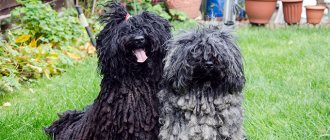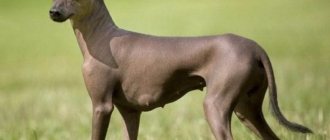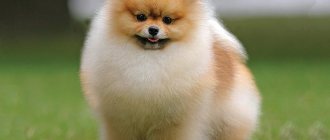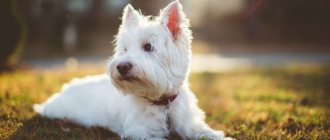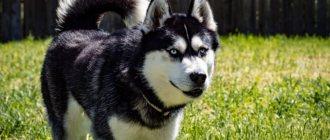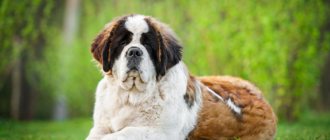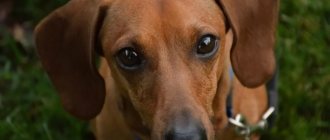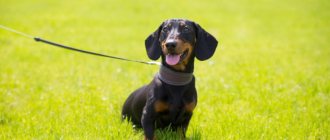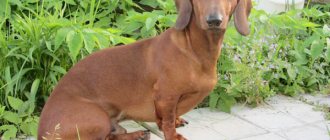The stereotype that a pet should be fluffy and soft has long been debunked. Hairless animals are popular not only because of their hypoallergenicity, but also because of their non-standard appearance. They are in no way inferior to dogs with long coats, they adapt better to hot climates, and most importantly, they do not shed.
There are only 3 recognized hairless breeds: Chinese Crested, Mexican Hairless and Peruvian Orchid. The rest are either completely uncommon in the world or appeared due to a genetic mutation.
Chinese Hairless Crested Dog
The most popular hairless dog, brought to Europe at the end of the 19th century from China. The animals cannot be called completely bald: they are characterized by the presence of a white crest, feathering on the ears and a tassel on the tail. As for the rest of the body, they are covered with thin elastic pinkish skin with bright brown pigment spots.
These dogs are not working dogs. Since ancient times, since the times of the Chinese Empire, they have been valued as sacred. And in European society, the breed became a symbol of eccentricity, so its first breeders were stars with an unusual image or lifestyle.
The dogs have a graceful figure: long thin limbs, a curved back with a smooth neck, and a lean belly. They are dexterous, fast, and capable of learning. In the Crested family, they are kind, flexible, and loving. They get along well with children and other pets, but require attention. Without care, such pets become sad and find it difficult for them to be without their owner for a long time.
In Russia, a puppy can be purchased for 10-20 thousand rubles. The price will depend not only on class and pedigree, but also on appearance. Downy Chinese Cresteds, completely covered with wool, will cost a little more.
History of the breed
The breed of hairless dog with a tuft is quite complex - it has a huge number of white spots. In general, standards were developed relatively recently - in the mid-twentieth century. At the same time, it was officially included in many registers. But don’t think that the breed is only half a century old. In fact, everything here is much more interesting and complex.
To begin with, Europeans first saw such an unusual dog in China. The British, greedy for such unusual curiosities, managed to take several dogs home. And just in time - due to numerous upheavals and unrest that swept China in the twentieth century, the breed was completely destroyed. Yes, yes, there is not a single bald dog left in the entire Celestial Empire. But in England they not only survived, but also aroused considerable interest from dog breeders. Several exported individuals gave rise to a new branch, which made it possible to revive the unusual breed. In 1966, standards were approved under which the Chinese Crested was included in all existing registers - not only British, but also worldwide.
Subsequently, during excavations, the remains of dogs were found, which experts identified as the ancestors of the Chinese Crested. Moreover, it was possible to establish that they lived around the fifth or sixth century AD!
It is not surprising that for a long time it was believed that China was the natural homeland of dogs. However, later discoveries forced a complete reconsideration of this version. The fact is that skulls of dogs that lived back in the 15th century BC were discovered in Mexico! That is, two thousand years before the Chinese Crested. They were given the sonorous name Sholoitzcuintli. They have not become extinct to this day, being the favorites of many ordinary Mexicans. But the fact is that they are so similar to modern Chinese Cresteds that experts have determined that the connection between the two breeds is undeniable. True, it is still not possible to establish how dogs could get from Mexico to China about one and a half to two thousand years ago.
Mexican hairless dog
Xoloitscuintles are native dogs that originated in southern North America . They were bred by the Aztec tribes, who considered animals as messengers of the afterlife. Pets were buried along with the owner, burned, and eaten. Despite such cruelty from humans, the Xolos remained good-natured and loyal.
Mexican hairless puppies are born with thick-footed, stocky puppies. By the age of one year, they take on the appearance of an adult dog: a fit body surrounded by thin folds of skin, a serious, confident look, strong limbs. It is normal for the breed to have hair on the head.
Xolos can be called calm, reserved, balanced. They feel great alone, but are fine with noisy families, children, and other animals. They need a leader-owner who can show the qualities of a real leader and choose the right approach in communication and education.
The Indians considered dogs to be healers. Due to their high body temperature, Xolos acted as a heating pad if their owner caught a cold.
Animals have sun-sensitive skin that is prone to dermatitis, which is important to consider when purchasing. In all other respects, the pets are unpretentious. It is difficult to find a real Mexican Hairless puppy in Russia; the average price for the breed is 50-60 thousand rubles . Purebred puppy is determined by three criteria:
- Dull face;
- Thick paws;
- Abundance of skin folds.
Description
Peruvian hairless dogs are similar in appearance to Mexican dogs, sometimes even dog handlers confuse them.
Mexican and Peruvian hairless dog.
Here are 6 subtle anatomical differences:
- Peruvians look more graceful and slender.
- The body is less elongated.
- The belly is lean, more toned.
- The line of the back is slightly convex in the lumbar region; in Mexican dogs it is always flat.
- The ears are set wider apart.
- The transition from the forehead to the bridge of the nose is more pronounced.
Peruvian litters produce puppies that are hairless and covered with close-fitting short hair. Hairless individuals have erect ears, while woolly ones sometimes fall down under the weight of hair.
There have been cases where puppies were born with hair, but during the first molt it fell out and did not grow back. Hairless Peruvians sometimes have tufts of hair on the top of their heads, tails, and paws.
Peruvian hairless dog puppy.
Among Peruvians there are also 3 dimensional types:
- Small – height 25 – 40 cm, weight 4 – 8 kg.
- Medium - height 41 - 50 cm, body weight 9 - 12 kg.
- Large ones - height 51 - 65 cm, weight 13 - 30 kg.
The color develops gradually. Puppies are born black or pink, then contrasting spots appear. The markings grow, merge and form the final color.
Peruvian dogs live 12 – 15 years, they have good health. In some lines, a tendency to inflammation of the pancreas and epilepsy is inherited. Light-colored animals quickly get sunburned and are predisposed to skin cancer.
Character of Peruvian Hairless
Peruvian Inca orchids adapt to any lifestyle and lifestyle of the owner and become real members of the family. They treat their family with tenderness and expect attention and approval in return. They do not run away during walks and always keep their owner in sight.
Peruvian hairless dog.
Inca orchids love the company of children. They make vigilant watchmen. Dogs do not trust strangers and do not tolerate the touch of others. They treat other animals with restraint and do not enter into conflicts. They can chase other people’s cats on the street, but they don’t touch “their own” cats at home. Peruvian dogs are easy to train, but do not tolerate rough handling.
American Hairless Terrier
Descendants of the Rat Terrier, the American Pied Piper, which arose due to a gene mutation. The hairless puppies that were born caused a wave of disapproval and could have gone unnoticed, but interested enthusiasts decided to create a new breed for people suffering from allergies.
The dogs cannot be called completely hairless: they have a small beard and sideburns. Puppies are born with down, but it completely falls out by 2 months. Animals acquire different colors with all sorts of pigmentation options. Their body is strong and robust, the head is dry and wrinkled with small eyes. But the main advantage of the breed is its large triangular ears.
Such pets are very sensitive and understanding. They love to “talk” with the owner and listen to him. The animals are non-aggressive and treat children and strangers normally. But you should not bring your Terrier into a house where there are guinea pigs or other rodents.
The lack of wool did not affect working qualities. American Hairless remain good rat catchers and are easy to train and train. In addition, they need regular intense physical and mental exercise. The only problem is the need for heat. It is better not to get a hairless dog in cold climates.
The breed is not common in post-Soviet countries, so it is difficult to find purebred puppies. Such a baby will cost no less than 50 thousand rubles.
Advantages and disadvantages
Selection successes make it possible to achieve almost bald skin due to several factors:
- genetic predisposition;
- mutational changes;
- fashion for a certain breed;
- requirements of society.
Hairless dogs are considered exotic due to their appearance, but at the same time their appearance can be frightening.
The advantage is as follows:
- absence of wool as an allergen for humans;
- minimal care;
- no specific dog smell;
- costs for special haircuts and combing in salons are minimized;
- They can easily tolerate hot weather.
Negative factors include:
- tendency to skin diseases;
- the need to comply with conditions for walking in the cold season, buying clothes;
- Some representatives need special education to develop a character “suited to the owner.”
Peruvian Inca Orchid
Rare breed in Europe, but common in Peru . The animals are believed to be non-native, having been brought from Africa or China. Images of similar dogs were found on the rock slabs of the ancient Incas. Peruvians treat dogs as deities. They are kept not only as a pet, but also to protect the house from evil spirits.
The dog got its name because of the funny crest on its head and the ability to change skin color depending on the seasons: in winter - light, beige, white; in summer – pinkish.
These are muscular, medium-sized animals with elastic skin. There are 3 growth varieties:
- mini (8 kg);
- standard (12 kg);
- maxi (25 kg).
Representatives of the breed are accustomed to hot climates and a nocturnal lifestyle, so owners should not worry about the pet sitting at home alone while everyone else is working. Orchids will most likely sleep all day.
The dogs are very loving and gentle, calm and affectionate. They are not characterized by playfulness, aggressive behavior, or isolation. The dogs have a lively mind, which allows them to be taught not only the basic program, but also to pick up additional commands or tricks.
Peruvian orchids quickly become attached to the family, respect not only one owner, but also all members of the household, and treat rodents and birds normally. But they don’t like strangers because of their pronounced territorial instinct.
Like other southern dogs, Peruvian Orchids are a rarity for the Russian Canine Society. There are several nurseries in the country that specialize in breeding the breed, so the cost of a puppy is 56-60 thousand rubles.
Briefly about the main thing
- A hairless dog looks too exotic. Suitable for those who want to show their love for something extraordinary and unusual.
- Many breeds have their own ancient history of origin, so it is advisable to inquire in advance about their character traits and upbringing conditions.
- Lack of wool is viewed in two ways. On the one hand, there is a guarantee of hypoallergenicity. On the other hand, the dog is poorly protected from external negative factors: bites, scratches, sun or frost.
- Depending on the chosen breed, it is possible to cultivate the character traits inherent in nature: hunter, companion, guard.
- Bald dogs require special care, which includes selecting living conditions and purchasing additional cosmetics.
Manchurian Hairless Dog
The breed is unrecognized and is considered an offshoot of the Chinese Crested. Appeared in Manchuria, bred as an absolutely hypoallergenic dog that never becomes infected with ectoparasites. Another feature is the complete absence of odor.
Manchurian dogs are similar in appearance to Crested dogs: long limbs, thin pink skin, feathering on the ears and tail. By nature, animals are soft, kind, obedient and flexible, often shy and withdrawn in the absence of proper socialization.
In Russia it is almost impossible to buy such a pet, but on the world market the cost of a puppy varies from 25 to 40 thousand rubles.
How to choose a puppy
Choosing a hairless puppy is often difficult because in one litter there are both hairless individuals and vice versa. This is normal, since each variety has certain characteristics. For example, Americans are always born with little fur, but after a couple of months they become hairless.
When choosing a Mexican, it is important to take into account that the best hairless puppy is the one with short legs, a blunt muzzle and skin with many folds. He will gradually become a confident dog with a graceful posture.
A puppy should be taken away from its mother only after it has been vaccinated and acquired important socialization skills. A puppy is usually adopted when it is about three months old. During the purchase, you need to carefully examine the baby. He must have a normal bite.
What you definitely shouldn't buy is a weak puppy. He may soon develop diseases, in particular hereditary ones. It is best to buy from a nursery with a good reputation.
Note! When choosing a pet in a nursery, you should definitely look at the type of litter: the babies and their mother, as well as the place where they are kept, must be fairly clean.
Ecuadorian hairless dog
The place of origin of the breed is Guatemala, it is believed that it appeared by mixing the blood of Peruvian orchids and Mexican naked ones. These dogs are difficult to find even in their historical homeland. They are not sold, they are not specially bred, there is not a single kennel that would offer to purchase an Ecuadorian Hairless puppy.
Animals are bred in Ecuadorian and African villages, in uncivilized forest tribes. Dogs help people around the house, hunt rodents and entertain children. Priests are confident in the ability of pets to drive out evil spirits and heal body and soul.
It is believed that this breed is the smartest among hairless ones, although there is no confirmation of this opinion.
Overall, Ecuadorians make excellent companions. They are cheerful, friendly, active, but willful and freedom-loving, like all aboriginal dogs.
Making up a diet
In general, the Chinese Crested is not too picky about food. The diet is quite simple to create.
You can also keep her on dry food, but in this case, be sure to always ensure that there is clean, fresh water in the bowl. And in general, dry food cannot be called a truly healthy diet. It is better to try to create a diet yourself.
Make sure your food contains enough vitamins A, D and E, as well as calcium and phosphorus. Various porridges with the addition of boiled or stewed vegetables and carefully chopped offal are suitable.
Also, be sure to give your dog fruit - she simply loves it. But, of course, this should be a delicacy, and not the basis of the diet.
Once every couple of weeks, have a fasting day - feed the dog only stewed or fresh cabbage to cleanse the stomach.
Hairless Deerhound (Scottish Greyhound)
An unrecognized breed that appeared due to a mutation in the standard Scottish Greyhounds. The recessive gene produces puppies in a litter of ordinary dogs that lose their hair by 3-4 weeks after birth. This phenomenon is not caused by a disease (alopecia), but such babies are discarded in order to prevent the mutation from developing.
Hairless Deerhounds are not suited for hunting due to their delicate skin and frail build, so they are functionally useless. And in their homeland, in Great Britain, greyhounds are valued precisely for their working qualities. But, despite such a non-standard appearance and poor health, Hairless Scots make excellent pets. They are loving, gentle, brave.
It is almost impossible to purchase a hairless individual; all puppies are left in the nursery for birth control. Although enthusiasts continue to fight for the independence of the breed and its recognition by the world canine organization.
Features of care
For any exotic representative you will have to select your own care products:
- a set of sunscreens to help avoid burns;
- special creams and lotions for sensitive skin;
- cosmetics for the care of the ears, eyes, and fingertips.
If you have to comb your pet, use gentle combs and brushes to avoid damaging the skin and fine hair.
Be sure to visit a veterinarian to rule out diseases. “Naked” pets are more likely than others to develop diseases of the kidneys, upper and lower respiratory tract. Allergies occur against the background of a large amount of household chemicals, so it is undesirable to get carried away with treating the room for disinfection purposes.
They need special nutrition that eliminates the possibility of injuring the oral cavity.
When going for a walk, it is advisable to take antiseptics with you to immediately treat wounds and abrasions.
Despite their outward confidence and calmness, hairless dogs originated from hunters. They are difficult to raise. If you do not have the skill of a dog handler, then it is better to entrust the socialization of the dog to a specialist.
At home, you need to take care of the absence of drafts. Walk minimally in bad weather conditions. A dog without hair freezes quickly and reacts sensitively to low temperatures. If you stay in the sun for a long time, you burn and sweat. You need to periodically pour cold water over it and carry a drinking bottle with you.
African hairless dog
The second name is Abyssinian sand terrier . One of the rarest breeds (about 400 individuals worldwide), it is very difficult to find representatives in Russia. Therefore, practically nothing is known about dogs.
Like all hairless dogs, Terriers were considered sacred and were used in ritual ceremonies. Almost nothing is known about the history of animals. Approximate place of origin: Africa. There is an opinion that the animals became the basis for the breeding of Chinese crested cats . The breeds are similar in size, build, and color. Abyssinians also have hair on their head and tail.
An interesting fact is that dogs cannot bark, but they can learn to do so by hearing the “conversation” of their relatives.
Regardless of whether the voice has emerged or not, Abyssinian Terriers are very brave and courageous, ready to protect their owner, despite their modest size (up to 25 cm at the withers). Animals do an excellent job of protecting property, but raising and training them is difficult, so natural habits and instincts often take over.
African Hairless cats are gentle and attentive, love their family, and treat children of all ages well. Dogs understand their owners on a moral level, support and reassure.
Summarize
Once you get acquainted with photographs and names of dogs representing hairless breeds, you will surely fall in love with these gentle creatures. However, before you bring a hairless puppy into your home, think carefully about whether you can provide him with proper care and give him your love and care. If yes, then a hairless dog will become not just your pet, but a family member and best friend!
The editors of most-beauty.ru ask you to write in the comments what other hairless dog breeds you know. And also write to us about whether you like dogs and what breeds you like best.
Diagnostics
First of all, the veterinarian will perform an external examination of the dog and take an anamnesis. Next, the doctor will choose one of the diagnostic methods to detect alopecia in a pet:
- Biopsy;
- Phototrichogram;
- Glow with an ultraviolet lamp;
- Biochemical, mycological and bacteriological studies of skin scrapings;
- General analysis of blood, urine and feces.
Read 10 symptoms of allergies in dogs and effective ways to treat the disease
An ultrasound may be prescribed to examine the functioning of the thyroid gland. The activity of B- and T-lymphocytes in the blood, the content of antigens and protein are being studied.
How much does a Xoloitzcuintle cost?
The price of a xoloitzcuintle starts from 10,000 rubles.
For this amount you can purchase a purebred puppy with partial compliance with the standard (pet class). Mexican hairless dogs with an elite pedigree will cost much more - 150,000 rubles. These animals will be able to win at the exhibition or be used in breeding work. Not everyone will agree to have a pet with a very unusual appearance. However, if you are fascinated by the idea of being the best friend of a dog with a reputation for repelling evil forces, the Xoloitzcuintle is your option!
Treatment of bald spots
Due to the variety of causes of alopecia in dogs, there is no single method for treating this scourge in veterinary practice. The nature of therapeutic measures is determined by the root cause of the pathology.
If bald spots are discovered on a four-legged friend, the owner should not self-medicate; he must seek qualified help. A veterinary specialist will conduct a number of necessary clinical, laboratory, and instrumental examination methods in order to establish the root cause of the pathology and prescribe effective treatment.
So, if problems with the endocrine glands have led to the loss of fur in a dog, then the veterinarian makes efforts to reduce the negative effect of hormones on the animal’s body. Based on a special biochemical blood test for the level of biologically active substances, the animal can be prescribed therapeutic doses of hormonal drugs.
In case of alopecia caused by external parasites, first of all, the coat is treated with special shampoos to destroy adult fleas and lice-eaters. In case of development of sarcoptic mange or demodicosis, the dog is prescribed anti-acaricidal drugs, for example, Ivermectin, Dectomax and others.
Treatment of fur against fleas
Bald spots caused by pyoderma are treated with a course of antibacterial drugs. In case of a fungal infection, the animal is prescribed ointments or tablets with an antimycotic effect.
If hair loss is caused by vitamin deficiencies or a deficiency of minerals in foods, a veterinarian will correct the diet and recommend multivitamin and mineral supplements to food.
Regardless of the cause of baldness in a four-legged pet, the veterinarian will certainly include immunostimulating drugs in the treatment regimen. Immunomodulators and vitamins strengthen the body's resistance and make the animal's immune system more resistant to aggressive environmental influences.
On the recommendation of a veterinarian, the animal’s diet is enriched with brewer’s yeast, multivitamins, such as Biorhythm, Unitabs Brevers Complex with Q10.
For information on the causes and treatment of baldness in dogs, watch this video:
